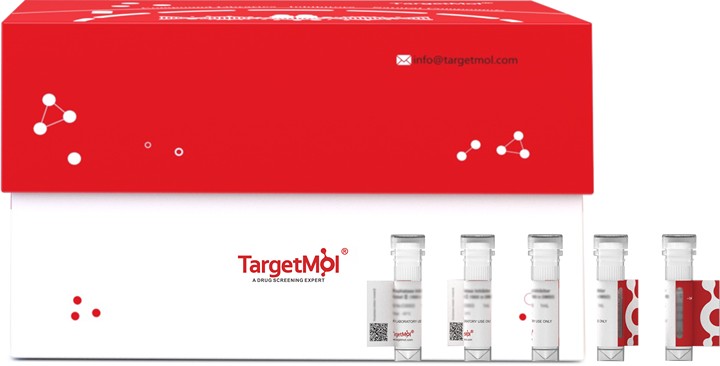 您的购物车当前为空
您的购物车当前为空
FLRT1 Protein, Human, Recombinant (His)
一键复制产品信息The three fibronectin leucine-rich repeat transmembrane (FLRT) proteins contain 10 leucine-rich repeats (LRR), a type III fibronectin (FN) domain, followed by the transmembrane region, and a short cytoplasmic tail. FLRT1 is expressed in kidney and brain, which is a target for tyrosine phosphorylation mediated by FGFR1 and implicates a non-receptor Src family kinase (SFK). All FLRTs can interact with FGFR1 and FLRTs can be induced by the activation of FGF signalling by FGF-2. The phosphorylation state of FLRT1, which is itself FGFR1 dependent, may play a critical role in the potentiation of FGFR1 signalling and may also depend on a SFK-dependent phosphorylation mechanism acting via the FGFR. This is consistent with an 'in vivo' role for FLRT1 regulation of FGF signalling via SFKs. Furthermore, the phosphorylation-dependent futile cycle mechanism controlling FGFR1 signalling is concurrently crucial for regulation of FLRT1-mediated neurite outgrowth. FLRT1, FLRT2 and FLRT3 are members of the fibronectin leucine rich transmembrane protein (FLRT) family. They may function in cell adhesion and/or receptor signalling. Their protein structures resemble small leucine-rich proteoglycans found in the extracellular matrix. FLRT3 shares 55% amino acid sequence identity with FLRT1.

FLRT1 Protein, Human, Recombinant (His)
一键复制产品信息| 规格 | 价格 | 库存 | 数量 |
|---|---|---|---|
| 5 μg | ¥ 428 | 6-8日内发货 | |
| 10 μg | ¥ 683 | 6-8日内发货 | |
| 20 μg | ¥ 1,130 | 5日内发货 | |
| 50 μg | ¥ 2,270 | 5日内发货 | |
| 100 μg | ¥ 4,430 | 5日内发货 |
产品信息
| 生物活性 | Measured by the ability of the immobilized protein to support the adhesion of Neuro‑2A mouse neuroblastoma cells. When cells are added to coated plates(5μg/mL, 100μL/well), approximately 50%-70% will adhere after 1 hour at 37℃. |
| 产品描述 | The three fibronectin leucine-rich repeat transmembrane (FLRT) proteins contain 10 leucine-rich repeats (LRR), a type III fibronectin (FN) domain, followed by the transmembrane region, and a short cytoplasmic tail. FLRT1 is expressed in kidney and brain, which is a target for tyrosine phosphorylation mediated by FGFR1 and implicates a non-receptor Src family kinase (SFK). All FLRTs can interact with FGFR1 and FLRTs can be induced by the activation of FGF signalling by FGF-2. The phosphorylation state of FLRT1, which is itself FGFR1 dependent, may play a critical role in the potentiation of FGFR1 signalling and may also depend on a SFK-dependent phosphorylation mechanism acting via the FGFR. This is consistent with an 'in vivo' role for FLRT1 regulation of FGF signalling via SFKs. Furthermore, the phosphorylation-dependent futile cycle mechanism controlling FGFR1 signalling is concurrently crucial for regulation of FLRT1-mediated neurite outgrowth. FLRT1, FLRT2 and FLRT3 are members of the fibronectin leucine rich transmembrane protein (FLRT) family. They may function in cell adhesion and/or receptor signalling. Their protein structures resemble small leucine-rich proteoglycans found in the extracellular matrix. FLRT3 shares 55% amino acid sequence identity with FLRT1. |
| 种属 | Human |
| 表达系统 | HEK293 Cells |
| 标签 | C-His |
| 蛋白编号 | Q9NZU1-1 |
| 别名 | SPG68,fibronectin leucine rich transmembrane protein 1 |
| 蛋白构建 | A DNA sequence encoding the human FLRT1 extracellular domain (Q9NZU1-1) (Met 1-Pro 524) was expressed, fused with a polyhistidine tag at the C-terminus. Predicted N terminal: Ile 21 |
| 蛋白纯度 | > 96 % as determined by SDS-PAGE |
| 分子量 | 57 kDa (predicted); 65 kDa (reducing condition, due to glycosylation) |
| 内毒素 | < 1.0 EU/μg of the protein as determined by the LAL method. |
| 蛋白性状 | Lyophilized powder |
| 缓冲液 | Lyophilized from a solution filtered through a 0.22 μm filter, containing PBS, pH 7.4. Typically, a mixture containing 5% to 8% trehalose, mannitol, and 0.01% Tween 80 is incorporated as a protective agent before lyophilization. |
| 复溶方法 | A Certificate of Analysis (CoA) containing reconstitution instructions is included with the products. Please refer to the CoA for detailed information. |
| 存储 | It is recommended to store recombinant proteins at -20°C to -80°C for future use. Lyophilized powders can be stably stored for over 12 months, while liquid products can be stored for 6-12 months at -80°C. For reconstituted protein solutions, the solution can be stored at -20°C to -80°C for at least 3 months. Please avoid multiple freeze-thaw cycles and store products in aliquots. |
| 运输方式 | In general, Lyophilized powders are shipping with blue ice. |
| 研究背景 | The three fibronectin leucine-rich repeat transmembrane (FLRT) proteins contain 10 leucine-rich repeats (LRR), a type III fibronectin (FN) domain, followed by the transmembrane region, and a short cytoplasmic tail. FLRT1 is expressed in kidney and brain, which is a target for tyrosine phosphorylation mediated by FGFR1 and implicates a non-receptor Src family kinase (SFK). All FLRTs can interact with FGFR1 and FLRTs can be induced by the activation of FGF signalling by FGF-2. The phosphorylation state of FLRT1, which is itself FGFR1 dependent, may play a critical role in the potentiation of FGFR1 signalling and may also depend on a SFK-dependent phosphorylation mechanism acting via the FGFR. This is consistent with an 'in vivo' role for FLRT1 regulation of FGF signalling via SFKs. Furthermore, the phosphorylation-dependent futile cycle mechanism controlling FGFR1 signalling is concurrently crucial for regulation of FLRT1-mediated neurite outgrowth. FLRT1, FLRT2 and FLRT3 are members of the fibronectin leucine rich transmembrane protein (FLRT) family. They may function in cell adhesion and/or receptor signalling. Their protein structures resemble small leucine-rich proteoglycans found in the extracellular matrix. FLRT3 shares 55% amino acid sequence identity with FLRT1. |





 |
|